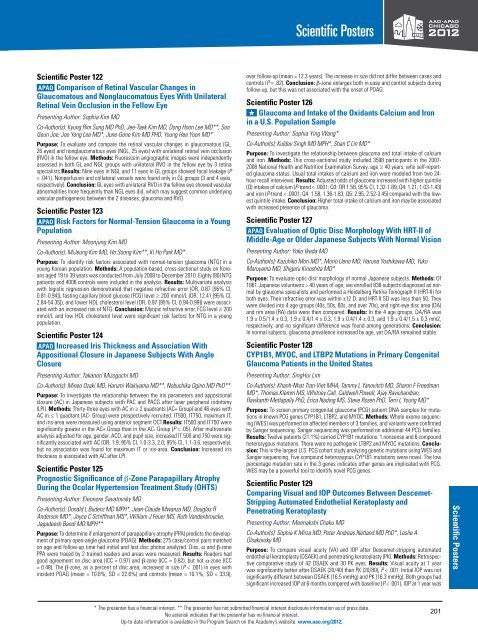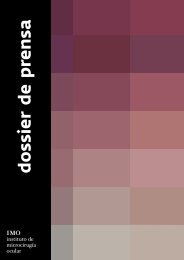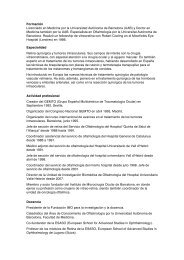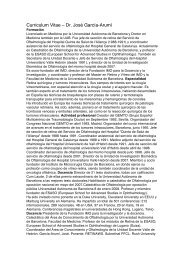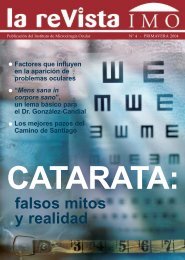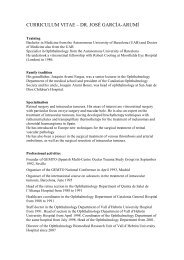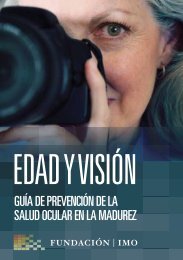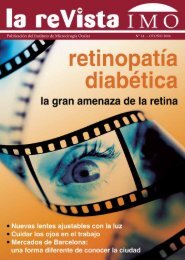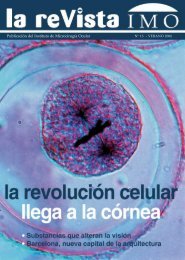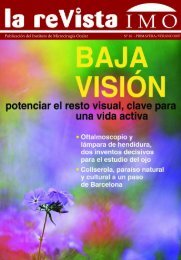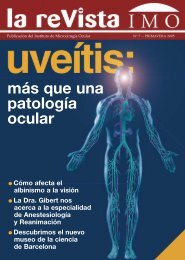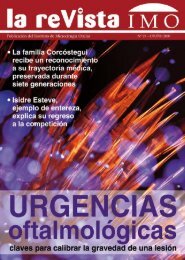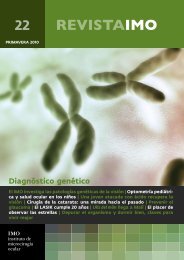FINAL PROGRAM - Imo
FINAL PROGRAM - Imo
FINAL PROGRAM - Imo
You also want an ePaper? Increase the reach of your titles
YUMPU automatically turns print PDFs into web optimized ePapers that Google loves.
Scientific Posters<br />
Scientific Poster 122<br />
APAO Comparison of Retinal Vascular Changes in<br />
Glaucomatous and Nonglaucomatous Eyes With Unilateral<br />
Retinal Vein Occlusion in the Fellow Eye<br />
Presenting Author: Sophia Kim MD<br />
Co-Author(s): Kyung Rim Sung MD PhD, Jee-Taek Kim MD, Dong Hoon Lee MD**, Soo<br />
Geun Joe, Joo Yong Lee MD*, June-Gone Kim MD PHD, Young Hee Yoon MD*<br />
Purpose: To evaluate and compare the retinal vascular changes in glaucomatous (GL,<br />
26 eyes) and nonglaucomatous eyes (NGL, 25 eyes) with unilateral retinal vein occlusion<br />
(RVO) in the fellow eye. Methods: Fluorescein angiographic images were independently<br />
assessed in both GL and NGL groups with unilateral RVO in the fellow eye by 3 retina<br />
specialists.Results: Nine eyes in NGL and 11 eyes in GL groups showed focal leakage (P<br />
= .041). Nonperfusion and collateral vessels were found only in GL groups (3 and 4 eyes,<br />
respectively). Conclusion: GL eyes with unilateral RVO in the fellow eye showed vascular<br />
abnormalities more frequently than NGL eyes did, which may suggest common underlying<br />
vascular pathogenesis between the 2 diseases, glaucoma and RVO.<br />
Scientific Poster 123<br />
APAO Risk Factors for Normal-Tension Glaucoma in a Young<br />
Population<br />
Presenting Author: Moonjung Kim MD<br />
Co-Author(s): MiJeung Kim MD, Ho Soong Kim**, Ki Ho Park MD*<br />
Purpose: To identify risk factors associated with normal-tension glaucoma (NTG) in a<br />
young Korean population. Methods: A population-based, cross-sectional study on Koreans<br />
aged 19 to 39 years was conducted from July 2008 to December 2010. Eighty (80) NTG<br />
patients and 4006 controls were included in the analysis. Results: Multivariate analysis<br />
with logistic regression demonstrated that negative refractive error (OR, 0.87 [95% CI,<br />
0.81-0.94]), fasting capillary blood glucose (FCG) level ≥ 200 mmol/L (OR, 12.41 [95% CI,<br />
2.84-54.35]), and lower HDL cholesterol level (OR, 0.97 [95% CI, 0.94-0.99]) were associated<br />
with an increased risk of NTG. Conclusion: Myopic refractive error, FCG level ≥ 200<br />
mmol/L and low HDL cholesterol level were significant risk factors for NTG in a young<br />
population.<br />
Scientific Poster 124<br />
APAO Increased Iris Thickness and Association With<br />
Appositional Closure in Japanese Subjects With Angle<br />
Closure<br />
Presenting Author: Takanori Mizoguchi MD<br />
Co-Author(s): Mineo Ozaki MD, Harumi Wakiyama MD**, Nobuchika Ogino MD PhD**<br />
Purpose: To investigate the relationship between the iris parameters and appositional<br />
closure (AC) in Japanese subjects with PAC and PACG after laser peripheral iridotomy<br />
(LPI). Methods: Thirty-three eyes with AC in ≥ 2 quadrants (AC+ Group) and 46 eyes with<br />
AC in ≤ 1 quadrant (AC- Group) were prospectively recruited. IT500, IT750, maximum IT,<br />
and iris-area were measured using anterior segment OCT.Results: IT500 and IT750 were<br />
significantly greater in the AC+ Group than in the AC- Group (P < .05). After multivariate<br />
analysis adjusted for age, gender, ACD, and pupil size, increased IT 500 and 750 were significantly<br />
associated with AC (OR, 1.9; 95% CI, 1.0-3.3, 2.0; 95% CI, 1.1-3.6, respectively),<br />
but no association was found for maximum IT or iris-area. Conclusion: Increased iris<br />
thickness is associated with AC after LPI.<br />
Scientific Poster 125<br />
Prognostic Significance of b-Zone Parapapillary Atrophy<br />
During the Ocular Hypertension Treatment Study (OHTS)<br />
Presenting Author: Eleonore Savatovsky MD<br />
Co-Author(s): Donald L Budenz MD MPH*, Jean-Claude Mwanza MD, Douglas R<br />
Anderson MD*, Joyce C Schiffman MS*, William J Feuer MS, Ruth Vandenbroucke,<br />
Jagadeesh Bandi MD MPH**<br />
Purpose: To determine if enlargement of parapapillary atrophy (PPA) predicts the development<br />
of primary open-angle glaucoma (POAG). Methods: 275 case/control pairs matched<br />
on age and follow-up time had initial and last disc photos analyzed. Disc, a and b-zone<br />
PPA were traced by 2 trained readers and areas were measured. Results: Readers had<br />
good agreement on disc area (ICC = 0.97) and b-zone (ICC = 0.82), but not a-zone (ICC<br />
= 0.48). The b-zone, as a percent of disc area, increased in size (P < .001) in eyes with<br />
incident POAG (mean = 10.6%, SD = 22.6%) and controls (mean = 10.1%, SD = 33.9),<br />
over follow-up (mean = 12.3 years). The increase in size did not differ between cases and<br />
controls (P = .82). Conclusion: b-zone enlarges both in case and control subjects during<br />
follow-up, but this was not associated with the onset of POAG.<br />
Scientific Poster 126<br />
H Glaucoma and Intake of the Oxidants Calcium and Iron<br />
in a U.S. Population Sample<br />
Presenting Author: Sophia Ying Wang*<br />
Co-Author(s): Kuldev Singh MD MPH*, Shan C Lin MD*<br />
Purpose: To investigate the relationship between glaucoma and total intake of calcium<br />
and iron. Methods: This cross-sectional study included 3598 participants in the 2007-<br />
2008 National Health and Nutrition Examination Survey, age ≥ 40 years, who self-reported<br />
glaucoma status. Usual total intakes of calcium and iron were modeled from two 24-<br />
hour recall interviews. Results: Adjusted odds of glaucoma increased with higher quintile<br />
(Q) intakes of calcium (P-trend < .0001; Q3: OR 1.58, 95% CI, 1.32-1.89; Q4: 1.21, 1.03-1.43)<br />
and iron (P-trend < .0001; Q4: 1.58, 1.36-1.83; Q5: 2.95, 2.52-3.45) compared with the lowest<br />
quintile intake. Conclusion: Higher total intake of calcium and iron may be associated<br />
with increased presence of glaucoma.<br />
Scientific Poster 127<br />
APAO Evaluation of Optic Disc Morphology With HRT-II of<br />
Middle-Age or Older Japanese Subjects With Normal Vision<br />
Presenting Author: Yoko Ikeda MD<br />
Co-Author(s): Kazuhiko Mori MD*, Morio Ueno MD, Haruna Yoshikawa MD, Yuko<br />
Maruyama MD, Shigeru Kinoshita MD*<br />
Purpose: To evaluate optic disc morphology of normal Japanese subjects. Methods: Of<br />
1861 Japanese volunteers > 40 years of age, we enrolled 838 subjects diagnosed as normal<br />
by glaucoma specialists and performed a Heidelberg Retina Tomograph II (HRT-II) for<br />
both eyes. Their refractive error was within ±12 D, and HRT-II SD was less than 50. They<br />
were divided into 4 age groups (40s, 50s, 60s, and over 70s), and right-eye disc area (DA)<br />
and rim area (RA) data were then compared. Results: In the 4 age groups, DA/RA was<br />
1.9 ± 0.5/1.4 ± 0.3, 1.9 ± 0.4/1.4 ± 0.3, 1.9 ± 0.4/1.4 ± 0.3, and 1.9 ± 0.4/1.5 ± 0.3 mm2,<br />
respectively, and no significant difference was found among generations. Conclusion:<br />
In normal subjects, glaucoma prevalence increased by age, yet DA/RA remained stable.<br />
Scientific Poster 128<br />
CYP1B1, MYOC, and LTBP2 Mutations in Primary Congenital<br />
Glaucoma Patients in the United States<br />
Presenting Author: SingHui Lim<br />
Co-Author(s): Khanh-Nhat Tran-Viet MHA, Tammy L Yanovitch MD, Sharon F Freedman<br />
MD*, Thomas Klemm MS, Whitney Call, Caldwell Powell, Ajay Ravichandran,<br />
Ravikanth Metlapally PhD, Erica Nading MS, Steve Rozen PhD, Terri L Young MD*<br />
Purpose: To screen primary congenital glaucoma (PCG) patient DNA samples for mutations<br />
in known PCG genes CYP1B1, LTBP2, and MYOC. Methods: Whole exome sequencing<br />
(WES) was performed on affected members of 3 families, and variants were confirmed<br />
by Sanger sequencing. Sanger sequencing was performed on additional 44 PCG families.<br />
Results: Twelve patients (21.1%) carried CYP1B1 mutations: 1 nonsense and 6 compound<br />
heterozygous mutations. There were no pathogenic LTBP2 and MYOC mutations. Conclusion:<br />
This is the largest U.S. PCG cohort study analyzing genetic mutations using WES and<br />
Sanger sequencing. Five compound heterozygous CYP1B1 mutations were novel. The low<br />
percentage mutation rate in the 3 genes indicates other genes are implicated with PCG.<br />
WES may be a powerful tool to identify novel PCG genes.<br />
Scientific Poster 129<br />
Comparing Visual and IOP Outcomes Between Descemet-<br />
Stripping Automated Endothelial Keratoplasty and<br />
Penetrating Keratoplasty<br />
Presenting Author: Meenakshi Chaku MD<br />
Co-Author(s): Sophia K Mirza MD, Peter Andreas Netland MD PhD*, Leslie A<br />
Olsakovsky MD<br />
Purpose: To compare visual acuity (VA) and IOP after Descemet-stripping automated<br />
endothelial keratoplasty (DSAEK) and penetrating keratoplasty (PK). Methods: Retrospective<br />
comparative study of 42 DSAEK and 30 PK eyes. Results: Visual acuity at 1 year<br />
was significantly better after DSAEK (20/40) than PK (20/80), P < .001. Initial IOP was not<br />
significantly different between DSAEK (16.5 mmHg) and PK (16.3 mmHg). Both groups had<br />
significant increased IOP at 6 months compared with baseline (P < .001). IOP at 1 year was<br />
Scientific Posters<br />
* The presenter has a financial interest. ** The presenter has not submitted financial interest disclosure information as of press date.<br />
No asterisk indicates that the presenter has no financial interest.<br />
Up-to-date information is available in the Program Search on the Academy’s website: www.aao.org/2012.<br />
201


